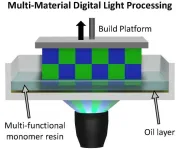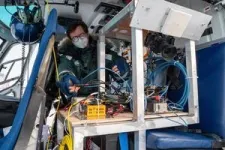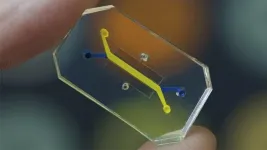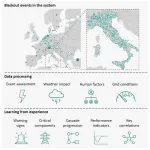(Press-News.org) AMES, Iowa – The U.S. National Science Foundation (NSF) is looking for materials that “revolutionize and engineer our future.”
Researchers at Iowa State University and the University of California, Santa Barbara think they can do just that by fundamentally changing Digital Light Processing – a type of 3D printing that users light rather than heat to quickly cure and harden liquid resin into plastic layers – to enable multi-material printing.
“We want to produce two material properties with the same resin,” said Adarsh Krishnamurthy, an associate professor of mechanical engineering and leader of the project at Iowa State. “That’s revolutionary in terms of materials for 3D printing.”
The researchers are using their expertise in materials chemistry, computational science, machine learning and materials characterization to find resins that, when exposed to different wavelengths of light, will solidify with different properties.
So, with one material, Digital Light Processing 3D printers could create products that are rigid in some places and flexible in others.
New materials for national needs
The project is one of 37 that NSF announced in September as part of a four-year, $72.5 million investment to “create novel materials to address grand societal challenges and develop the scientific and engineering workforce of tomorrow.” The effort is part of the federal, multi-agency Materials Genome Initiative that’s focused on quickly advancing materials invention and use.
“By integrating numerous research disciplines across NSF as well as federal and industrial partnerships, this program truly revolutionizes the design, discovery and development of new materials for addressing urgent national needs,” said Sethuraman Panchanathan, director of the NSF.
The program awarded Iowa State researchers $800,000 to use artificial intelligence and machine learning algorithms to help develop new resins which can be printed with different properties. Krishnamurthy said the Iowa State team’s experience with machine learning tools will help the researchers evaluate options and quickly identify potential materials.
The program also awarded UCSB researchers $1.1 million for their share of the project. Led by Michael Chabinyc, a professor of materials, the UCSB researchers will focus their work on polymer chemistry.
(See sidebar for a full roster of researchers from Iowa State and UCSB.)
Krishnamurthy said the Iowa State and UCSB researchers will focus their efforts on building special biomedical platforms with structured surfaces of varying stiffnesses that can promote and direct the growth of cell cultures.
Currently, such cultures are grown on hard glass or a soft silicon polymer.
“But that’s not how the body is,” Krishnamurthy said. “The body has both – hard bone and soft tissue. The different stiffnesses promote better cell growth.”
Computing material improvements
In addition to printing and testing actual materials, the researchers will develop a “digital twin” of the system. They can use this to simulate and predict how different resins will respond to a spectrum of light wavelengths and exposures.
Machine learning tools will also save the researchers tedious, time-consuming lab work by trimming the list of potential resins suitable for study and development.
In addition, the researchers will use a machine learning technique called reinforcement learning to make sure advances in experiments or theories lead to overall advancements of multi-material, light-based 3D printing.
All that computational science can help the Iowa State-UCSB team advance the Materials Genome Initiative’s goal of “discovering, manufacturing, and deploying advanced materials twice as fast and at a fraction of the cost compared to traditional methods.”
– 30 –
The research team
In addition to project leaders Adarsh Krishnamurthy of Iowa State University and Michael Chabinyc of the University of California, Santa Barbara, the research team includes:
Iowa State, Baskar Ganapathysubramanian and Soumik Sarkar
UCSB, Christopher Bates and Angela Pitenis END
Researchers developing ‘revolutionary’ multi-material for light-based 3D printing
2023-10-18
ELSE PRESS RELEASES FROM THIS DATE:
New institute aims to address gap in nation’s health care system through highly effective yet overlooked nutrition interventions
2023-10-18
A newly launched, first-of-its-kind institute aims to address a glaring gap in the medical system by working to integrate food-based nutrition interventions into health care to treat disease and advance health equity.
The Food is Medicine Institute at the Friedman School of Nutrition Science and Policy at Tufts University, launched today, establishes a university-wide initiative aimed at transforming health care through scalable food-based interventions such as: medically tailored meals and prescriptions for produce; nutrition education for doctors; and clinical care, electronic health record, and reimbursement pathways for nutrition-based tools to help treat or prevent ...
Wyss Institute at Harvard University wins BARDA contract to leverage human Organ Chips to advance knowledge and drug-discovery for broad range of health security threats
2023-10-18
By Benjamin Boettner
(BOSTON) — The Biomedical Advanced Research and Development Authority (BARDA), part of the Administration for Strategic Preparedness and Response (ASPR) at the U.S. Department of Health and Human Services (HHS), partnered with the Wyss Institute at Harvard University to support the Institute in advancing its human Organ Chip platform and drug discovery capabilities to better understand the illness and injuries that result from a broad range of health security threats, including high doses of radiation, as well as predicting and evaluating ...
Google Quantum AI and Stanford University researchers use measurements to generate quantum entanglement and teleportation
2023-10-18
Quantum mechanics is full of weird phenomena, but perhaps none as weird as the role measurement plays in the theory. Since a measurement tends to destroy the “quantumness” of a system, it seems to be the mysterious link between the quantum and classical world. And in a large system of quantum bits of information, known as “qubits,” the effect of measurements can induce dramatically new behavior, even driving the emergence of entirely new phases of quantum information.
This happens when two competing effects come to a head: interactions and measurement. In a quantum system, when the qubits interact ...
Cedars-Sinai uses AI to identify people with abnormal heart rhythms
2023-10-18
Investigators from the Smidt Heart Institute at Cedars-Sinai found that an artificial intelligence (AI) algorithm can detect an abnormal heart rhythm in people not yet showing symptoms.
The algorithm, which identified hidden signals in common medical diagnostic testing, may help doctors better prevent strokes and other cardiovascular complications in people with atrial fibrillation—the most common type of heart rhythm disorder.
Previously developed algorithms have been primarily used in white ...
How to build greener data centers? Scientists say crank up the heat
2023-10-18
Colder is not always better for energy-hungry data centers, especially when it comes to their power bills. A new analysis says that keeping the centers at 41°C, or around 105°F, could save up to 56% in cooling costs worldwide. The study, publishing October 10 in the journal Cell Reports Physical Science, proposes new temperature guidelines that may help develop and manage more efficient data centers and IT servers in the future.
“The cooling system accounts for over one-third of the data center’s total energy consumption, so many studies ...
As surging threats teeter electrical power grids, scientists offer insights to make them more resilient
2023-10-18
Power grids—the web of electrical networks that sprawl across countries and continents—are under stress. Extreme weather events and volatile energy demands often push the system to the brink. Although these high-impact events can be very damaging, often overlooked is the impact of minor disruptions that trigger a domino effect throughout the system, according to a study analyzing European power blackouts. The findings, published October 18 in the journal Joule, showed that recovering power within 13 hours can reduce up to ...
Telehealth supports retention in treatment for opioid use disorder
2023-10-18
Starting buprenorphine treatment for opioid use disorder through telehealth was associated with an increased likelihood of staying in treatment longer compared to starting treatment in a non-telehealth setting, according to a new study analyzing Medicaid data from 2019-2020 in Kentucky and Ohio. Published in JAMA Network Open, these findings add to a growing body of evidence demonstrating positive outcomes associated with the use of telemedicine for treatment of opioid use disorder.
In Kentucky, 48% of those who started buprenorphine treatment via telehealth remained in treatment for 90 continuous days, compared ...
Researchers design gene therapy that can effectively target glioblastoma
2023-10-18
In a first-in-human phase 1 trial in 41 patients with recurrent glioblastoma, an oncolytic virus treatment designed by Brigham researchers extended survival, especially among those with pre-existing viral antibodies
Therapy turns ‘immune desert’ into inflammatory cancer-fighting zone
Study demonstrated the safety and preliminary efficacy of a novel gene therapy for glioblastoma
Glioblastoma (GBM), an aggressive brain cancer, is notoriously resistant to treatment, with recurrent GBM associated with survival of less than 10 months. Immunotherapies, ...
From a five-layer graphene sandwich, a rare electronic state emerges
2023-10-18
Ordinary pencil lead holds extraordinary properties when shaved down to layers as thin as an atom. A single, atom-thin sheet of graphite, known as graphene, is just a tiny fraction of the width of a human hair. Under a microscope, the material resembles a chicken-wire of carbon atoms linked in a hexagonal lattice.
Despite its waif-like proportions, scientists have found over the years that graphene is exceptionally strong. And when the material is stacked and twisted in specific contortions, it can take on surprising electronic behavior.
Now, MIT physicists have discovered another surprising property ...
Treatment rates for mental disorders among children and adolescents
2023-10-18
About The Study: The results of this meta-analysis of 40 studies including 310,000 children and adolescents suggest that, in general, the treatment rates for mental disorders among children and adolescents were low, especially for depression and anxiety. Targeted intervention policies and effective measures should be designed and implemented to improve treatment rates of psychiatric disorders among youths.
Authors: Yuanyuan Xiao, Ph.D., of Kunming Medical University in Kunming, Yunnan, China, is the corresponding author.
To access the embargoed study: Visit our For The Media website at this link https://media.jamanetwork.com/
(doi:10.1001/jamanetworkopen.2023.38174)
Editor’s ...







